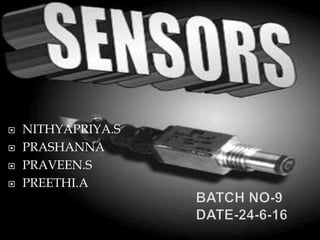
SENSORS A DISCUSSION
- 1. NITHYAPRIYA.S PRASHANNA PRAVEEN.S PREETHI.A
- 2. CONTENTS Sensor Types Of Sensor Smoke Sensor Parking Sensor Pedometer Pressure Sensor Accelerometer
- 3. What is sensor? An object that detects changes or events in the environment and produces corresponding output A type of transducer Example: A thermometer Mechanical Temperature Chemical Optical 1
- 5. SMOKE DETECTOR A device that senses smoke typically as an indicator of fire Size-150 mm in diameter and 25 mm in thickness Ionisation Optical Projected beam Aspirating Carbonmonoxide Types 3
- 6. Working of optical smoke detector4
- 7. Working of ionisation smoke detector 5
- 8. Advantages Optical smoke detector contains no radioactive material Ionisation smoke detectors are cheaper than other types of smoke alarms Carbon monoxide alarms are used in addition to smoke alarms for increased warning Needs regular checking and replacement of batteries Triggers false alarms when installed near steam rooms, stoves, toaster ovens and high dust areas Optical smoke detectors are expensive Disadvantages 6
- 10. INTRODUCTION Parking sensors are used for alert the driver to obstacles while parking. These sensors use electromagnetic or ultrasonic sensors. The parking sensor is called as Reverse Aid which was invented by Dr . Tony Heyes. After patenting the sensor , Heyes offered it to Jaguar cars. 8
- 11. Electromagnetic System These sensor was invented by Mauro Del Signore In 1992. These sensors rely on the vehicle moving slowly and smoothly towards the object to be avoided. These sensors are mounts on the inner side of the bumper. 9
- 12. Ultrasonic Systems These systems feature ultrasonic proximity detectors to measure the distances to nearby objects through sensors. Rear sensors are activated by selecting the reverse gear and deactivated by selecting other gear. These system may not detect flat objects or large object to reflect sound. These sensors are driven by intermittent waves called Burst waves. 10
- 13. PEDOMETER 11
- 14. INTRODUCTION Pedometer is a sensor that is used to count the steps taken by the person. They are becoming popular as an exercise counter and motivator. These sensors are integrated into electronic devices. The first pedometer was developed by Abraham-Louis Perrelet. 12
- 15. TECHNOLOGY The technology includes a mechanical sensor and software to count steps. Advanced step counters relay on MEMS interial sensors and software to detect steps. Pedometer are accurate at flat surface. 13
- 16. INTEGRATIONIN ELECTRONICDEVICES 1. NIKE&iPod 2. FITBIT. 3. NTT DOCOMO FUJITSU PHONE. 4. NOKIA 5500 SPORTS PHONE. 5. SONY ERICSSON WALKMAN PHONE. 6. APPLE PRODUCTS. 14
- 18. TYPES OF PRESSURE SENSOR Absolute Pressure Sensor Differential Pressure Sensor Gauge Pressure Sensor 16
- 19. TYPES OF PRESSURE SENSORS Strain Gauge Type 17
- 22. Applications of Pressure Sensors Touch Screen Devices Automotive Industry Bio Medical Instrumentation Industrial Uses Aviation Marine Industry Leak testing Marine Industry Pressure sensing Altitude sensing Flow sensing Level / depth sensing Ratiometric Correction of Transducer Output 20
- 23. What is an Accelerometer? An accelerometer is an ELECTROMECHANICAL device that measures acceleration ("g-force") forces which may be STATIC, or they could be DYNAMIC. These are sensing transducers that provide an output proportional to acceleration, vibration, and shock. Accelerometers are available that can measure acceleration in one, two, or three orthogonal axes. MODES OF USAGE For inertial measurement of velocity and position. As a inclination, tilt, or orientation sensor. As a vibration or shock sensor. 21
- 24. Types and working of Accelerometer Capacitive Piezoelectric Piezoresistive(electrical resistance) Heat transfer(changes in heat) Hall effect(change in magnetic field) 22
- 25. Working of capacitive and piezoelectric accelerometer s.no capacitive piezoelectric 1. Output voltage depends on the distance between two planar surfaces. Output voltage depends on the pressure exerted on the crystal 2. Changing the gap between the plates changes the electrical capacity of the system, which can be measured as output. Mass exerted over the crystal may produce piezoelectric effect due to which the voltage is produced adv high accuracy and stability. no need for electric supply to sense, used to measure shock disa d A Supply is needed Not used to measure g force 23
- 26. Working of accelerometer chip in mobiles Below the red electrode, and separated from it by an air gap, there's a second electrode (purple). The air gap between the two electrodes means the red and purple electrodes work together as a capacitor. As you move the accelerometer and the red electrode moves up and down, the distance between the red and purple electrodes changes, and so does the capacitance between them hence an equivalent voltage output is produced. 24
- 27. Specifications Analog/digital Number of axes Output range (maximum swing) Sensitivity (voltage output per g) Dynamic range Mass POTENTIAL APPLICATIONS To measure tilt angle. To sense movement. In laptops to protect hard drives from damage. Airbag deployment systems for modern automobiles. In self-balancing robots, auto pilot mode. physical therapy devices. In wireless gaming consoles and mobile phones. 25
- 28. Recent applications. Air writing Pretouch In drones and other flying objects Seismometers-used to measure earthquakes And also to record earthquake To measure cable noise(produced due to current flow). 26
- 29. REFERENCE en.m.wikipedia.org www.sensormag.com www.engineersgarage.com www.first-sensor.com>pressure-types www.allsensors.com>applications http://www.sensorwiki.org/doku.php/sensors/accelerometer http://www.dimensionengineering.com/info/accelerometers http://www.explainthatstuff.com/accelerometers.html
- 30. THANK YOU 30